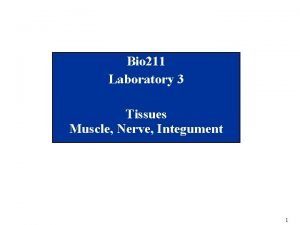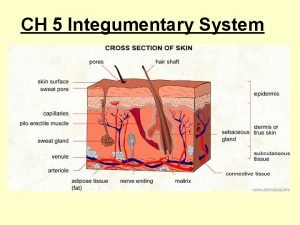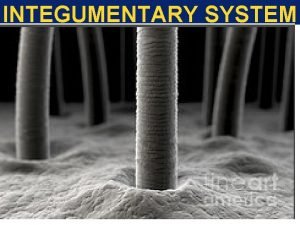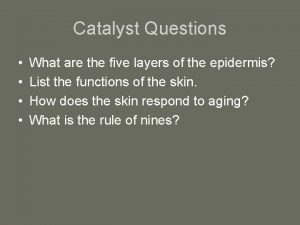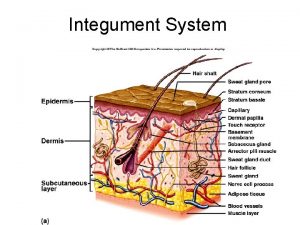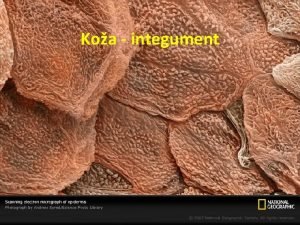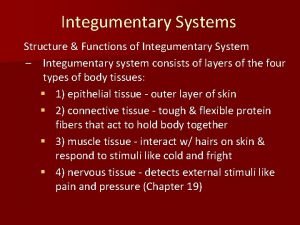The Integumentary System 1 Integumentary system Integument is




















- Slides: 20

The Integumentary System 1

Integumentary system • Integument is skin • Integumentary system is the skin and the organs derived from it (hair, glands, nails) • One of the largest organs – surface area of between - 1. 5 -2. 0 square meters , – total average weight : 10 -11 lbs. – Largest sense organ in the body • The study of the skin is Dermatology 2

Functions of skin 1. Covers and protects the body from – Pathogens – Injury – Ultra-violet radiation 2. Regulate body temperature through – Sweating – Dilatation/constriction of blood vessels 3. Excretes Waste as - Urea - sweat 4. Reduces water loss - Keeps the body from drying out 5. Houses sensory receptors 3

Anatomy of skin 4

Anatomy of skin • Epidermis • Dermis • Subcutaneous layer or hypodermis 5

Epidermis • Stratified squamous epithelium – Avascular (contains no blood vessels) – Most of the cells in the epidermis are keratinocytes. Inner part is composed of living cells Outer part is composed of dead cells 6

Epidermis- Four types of cells 1. Keratinocytes • produce the protein keratin, which helps to protect the skin and underlying tissue from heat, microbes, and chemicals • Produce lamellar granules, which release a waterproof sealant. 2. Melanocytes • produce the pigment melanin which contributes to skin color and absorbs damaging ultraviolet (UV) light. • Help in the production of Vitamin D 7

Epidermis- Four types of cells 3. Langerhans cells (Dendritic cells) • derived from bone marrow (star shaped cells) • participate in immune response • play a role in the development of skin allergies 4. Merkel cells • contact a sensory structure called a tactile (Merkel) disc that helps in the sensation of touch 8

Layers and cells of epidermis 9

Layers (from deep to superficial) 5 layers: • Stratum basale (stratum germinativum) • Stratum spinosum • Stratum granulosum • Stratum lucidum (only in palms and soles) • Stratum corneum 10

Layers (from deep to superficial) – Stratum basale or germinativum – single row of cells attached to dermis; youngest cells – Stratum spinosum – provides strength and flexibility to the skin, 8 to 10 cell layers are held together by desmosomes. – Stratum granulosum – layers of flattened keratinocytes, producing keratin (hair and nails made of it also) – Stratum lucidum (only on palms and soles) – Stratum corneum – horny layer (cells dead, many layers thick) 11

Dermis • The dermis is the middle layer of skin • composed of dense irregular connective tissue collagen & elastic fibers, fibroblasts, macrophages & fat cells. • Contains hair follicles, glands, nerves & blood vessels. • Two major regions of dermis - Papillary region - Reticular region 12

Dermis 13

Dermis - Papillary Region • Top 20% of dermis • Finger like projections are called dermal papillae – anchors epidermis to dermis – contains capillaries that feed epidermis – contains Meissner’s corpuscles (a sensory nerve ending that is sensitive to mechanical stimuli like touch) & free nerve endings for sensations of heat, cold, pain, tickle, and itch 14

Dermis - Reticular Region • Dense irregular connective tissue • Contains interlacing collagen and elastic fibers • Packed with oil glands, sweat gland ducts, fat & hair follicles • Provides strength, extensibility & elasticity to skin – Stretch marks are dermal tears from extreme stretching • Epidermal ridges form in fetus – Fingerprints are left by sweat glands open on ridges – Increase grip of hand

Hypodermis • Hypodermis (Gk) = below the skin • “Subcutaneous” (Latin) = below the skin • Also called “superficial fascia” “fascia” (Latin) =band; in anatomy: sheet of connective tissue • Fatty tissue which stores fat and anchors skin • Attaches the reticular layer to the underlying organs • It contains larger blood vessels and nerves than those found in the dermis. 16

Hypodermis

Hypodermis • It is essentially composed of a type of cells specialised in accumulating and storing fats, known as adipocytes. • These cells are grouped together in lobules separated by connective tissue - collagen and elastin fibres • The number of adipocytes varies among different areas of the body, while their size varies according to the body's nutritional state. • It acts as energy reserve • provides some minor thermoregulation via insulation

Summery……… • Integumentary system – Definition – Characteristics – Functions – Layers • Epidermis – Charecteristics – Cells of epidermis – Layers of epidermis • Dermis – Characteristics – Functions – Figure • Subcutaneous – Characteristics – Functions – Figure 19

summery……. Skin layer: – Dermis • Characteristics • Functions • Figure – Subcutaneous • Characteristics • Functions • Figure
 Contains several layers of polygonal keratinocytes
Contains several layers of polygonal keratinocytes Organum germinativum
Organum germinativum Integument
Integument Integument
Integument Exfoliative dermatitis
Exfoliative dermatitis Integument
Integument Bio 211
Bio 211 Epidermis
Epidermis Integumentary system vocabulary
Integumentary system vocabulary Pig integumentary system
Pig integumentary system Epidermis layers
Epidermis layers The integumentary system exercise 7
The integumentary system exercise 7 Integumentary system vocab
Integumentary system vocab The integumentary system
The integumentary system Integumentary assessment
Integumentary assessment Excretory system analogy
Excretory system analogy Cat integumentary system
Cat integumentary system The integumentary system
The integumentary system Integumentary system components
Integumentary system components Integumentary system effects of aging
Integumentary system effects of aging Section 36-3 the integumentary system
Section 36-3 the integumentary system






